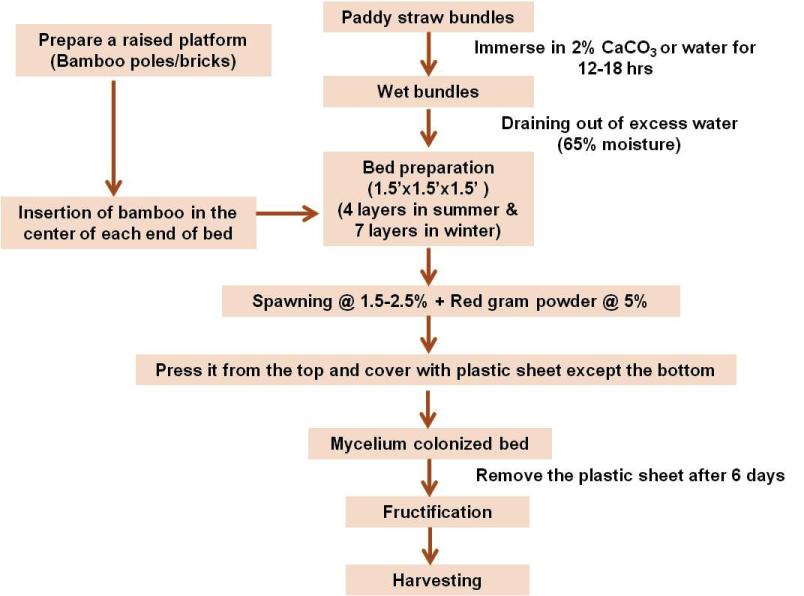धान के पुआल मशरूम की खेती: ओडिशा के किसानों के लिए आजीविका का अवसर
Mushroom is known as white vegetable or boneless vegetarian meat. They are rich source of protein, fiber, vitamins and minerals and low in calories, carbohydrates, fat, sodium and cholesterol. FAO recognizes mushrooms as the right source of protein to fight protein malnutrition.
The ancient Romans perceived mushroom as “Food of the Gods”. Mushrooms are recognized as immunity booster with numerous health benefits and have unique taste.
In India, about 500 million tons crop residues are generated annually out of which 92 million tons is burned (NPMCR, 2014). Mushroom cultivation offers an eco-friendly sustainable approach of agriculture residue management and produce protein rich quality food per unit area
Paddy straw mushroom (Volvariella volvacea) has excellent taste and flavour. It can easily cultivate both in indoor and outdoor condition under the shade of tree and in open condition in the backyard.
Paddy straw mushroom can also be grown as an intercrop, compatible with most orchard and plantation crops. It can also be grown as an intercrop, compatible with most orchard and plantation crops. It is very popular in Odisha and can be cultivated for 8 to 9 months (March to November). Due to its fast growing nature it is more profitable.
Paddy straw mushroom requires a high temperature (35±2ºC) for better and early hyphal growth. For the formation of fruiting bodies ideal condition is 32±2ºC temperature with 80-90 % RH (Chang and Hayes, 1978). Mycelium does not grow at all if the temperature is raised to 45 °C or dropped to 15 °C. Under favourable growing conditions total crop cycle is completed within 3-4 weeks times.
Nutritional composition of paddy straw mushroom
|
Composition (quantity/100g fresh mushroom) |
|||
|
Moisture |
90.40 (g) |
Iron |
1.70 (g) |
|
Fat |
0.25 (g) |
Calcium |
5.60 (mg) |
|
Protein |
3.90 (g) |
Thiamine |
0.14 (mg) |
|
Crude fibre |
1.87 (g) |
Riboflavin |
0.61 (mg) |
|
Phosphorus |
0.10 (g) |
Niacin |
2.40 (mg) |
|
Potassium |
0.32 (g) |
Ascorbic acid |
18.00 (mg) |
Source: Verma, 2002
Climatic requirement for paddy straw mushroom cultivation
|
Temperature |
: |
30-380C |
|
Relative humidity (RH) |
: |
85-90% |
|
Light |
: |
1000 lux |
|
Substrate pH |
: |
6.5-7.0 |
|
Substrate moisture |
: |
65% |
|
Oxygen requirement |
: |
more during fruiting stage |
Inputs required for mushroom bed preparation
The following inputs are essential for preparation of single bed of paddy straw mushroom
Standard bed size – 1.5’x1.5’x1.5’
Paddy straw – 7 kg (14 Bundles)
Spawn – 200g (3%)
Additives (Gram powder) – 200g (3%)
Polythene sheet – 6’x 6’
Infrastructure
The following infrastructures required for paddy straw mushroom cultivation
- Thatched shed
- Soaking tank
- Chaff cutter
- Thermometer
- Hygrometer
- Sprayer
Outdoor method of paddy straw mushroom cultivation

The outdoor cultivation method is commonly practiced in Odisha inside the coconut and banana plantation. The important steps required for outdoor cultivation method are as follows:
Harvesting of paddy straw mushroom
Harvesting is done twice or thrice in a day (morning, noon and afternoon). The first fruiting flush occurs about 14 days after incubation and continues for 3 days (accounting around 75% of the total yield). After first harvesting, water is sprinkled over the bed and covered again with the plastic sheet to build up the temperature. The second fruiting flush will appear within 7-8 days and lasts for 2-3 days (accounts for rest 25% of the total yield). The mature mushrooms are hand picked by twisting them at the base. Knives or scissors should not be used for harvesting because the stalk left behind on the bed/substrate will rot and be attacked by pests and contaminated by moulds. To enhance higher protein content, better palatability and longer shelf life harvesting should be done at the button to egg-shaped stages. Cap-opening in the paddy straw mushroom affect their marketability significantly
References
Ahlawat, O.P. (2003). Survivability of paddy straw mushroom cultures on storing under different conditions. Indian J. Mushroom, 21 (1 and 2), 13-18.
Chang S. T., Hayes, W.H. (1978). Biology and cultivation of edible mushrooms. Paddy straw mushroom (Volvariella volvacea). 102-109.
Chang S. T. (1982). Cultivation of Volvariella mushrooms in South East Asia. In : Tropical Mushrooms – Biology, Nature and Cultivation Methods (Chang ST and Quimio TH, Eds.). Chinese University Press, Hong Kong, pp. 221-252.
Hu K.Y. (1985). Indoor cultivation of straw mushroom in Hong Kong. Mushroom Newsl. Trop., 6(2): 4-9.
NPMCR (2014). National policy for management of crop residues. New Delhi, India: Government of India, Ministry of Agriculture, Department of Agriculture & Cooperation (Natural Resource Management Division), Krishi Bhawan.
Verma R. N. (2002). Cultivation of paddy straw mushroom (Volvariella spp.). In : Recent Advances in the Cultivation Technology of Edible Mushrooms. (Verma, RN and Vijay B, Eds.). National Research Centre for Mushroom, Solan (HP), India. pp. 221-220.
Authors:
Tania Seth*, Chaitrali S. Mhatre, Arun K. Panda and Praveen Jakhar
ICAR-Central Institute for Women in Agriculture, Bhubaneswar-751003, Odisha
*Corresponding author’s email:
